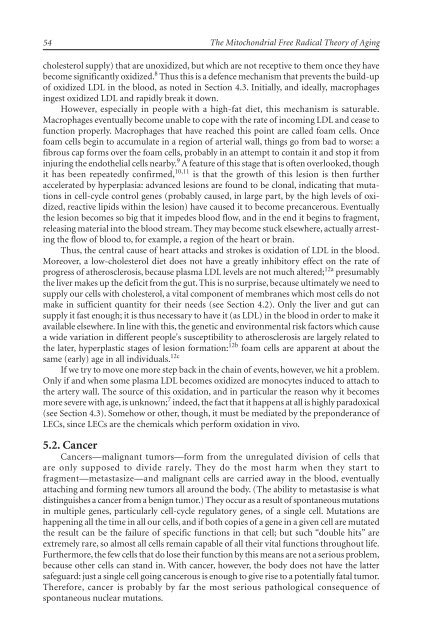The Mitochondrial Free Radical Theory of Aging - Supernova: Pliki
The Mitochondrial Free Radical Theory of Aging - Supernova: Pliki
The Mitochondrial Free Radical Theory of Aging - Supernova: Pliki
You also want an ePaper? Increase the reach of your titles
YUMPU automatically turns print PDFs into web optimized ePapers that Google loves.
54<br />
<strong>The</strong> <strong>Mitochondrial</strong> <strong>Free</strong> <strong>Radical</strong> <strong>The</strong>ory <strong>of</strong> <strong>Aging</strong><br />
cholesterol supply) that are unoxidized, but which are not receptive to them once they have<br />
become significantly oxidized. 8 Thus this is a defence mechanism that prevents the build-up<br />
<strong>of</strong> oxidized LDL in the blood, as noted in Section 4.3. Initially, and ideally, macrophages<br />
ingest oxidized LDL and rapidly break it down.<br />
However, especially in people with a high-fat diet, this mechanism is saturable.<br />
Macrophages eventually become unable to cope with the rate <strong>of</strong> incoming LDL and cease to<br />
function properly. Macrophages that have reached this point are called foam cells. Once<br />
foam cells begin to accumulate in a region <strong>of</strong> arterial wall, things go from bad to worse: a<br />
fibrous cap forms over the foam cells, probably in an attempt to contain it and stop it from<br />
injuring the endothelial cells nearby. 9 A feature <strong>of</strong> this stage that is <strong>of</strong>ten overlooked, though<br />
it has been repeatedly confirmed, 10,11 is that the growth <strong>of</strong> this lesion is then further<br />
accelerated by hyperplasia: advanced lesions are found to be clonal, indicating that mutations<br />
in cell-cycle control genes (probably caused, in large part, by the high levels <strong>of</strong> oxidized,<br />
reactive lipids within the lesion) have caused it to become precancerous. Eventually<br />
the lesion becomes so big that it impedes blood flow, and in the end it begins to fragment,<br />
releasing material into the blood stream. <strong>The</strong>y may become stuck elsewhere, actually arresting<br />
the flow <strong>of</strong> blood to, for example, a region <strong>of</strong> the heart or brain.<br />
Thus, the central cause <strong>of</strong> heart attacks and strokes is oxidation <strong>of</strong> LDL in the blood.<br />
Moreover, a low-cholesterol diet does not have a greatly inhibitory effect on the rate <strong>of</strong><br />
progress <strong>of</strong> atherosclerosis, because plasma LDL levels are not much altered; 12a presumably<br />
the liver makes up the deficit from the gut. This is no surprise, because ultimately we need to<br />
supply our cells with cholesterol, a vital component <strong>of</strong> membranes which most cells do not<br />
make in sufficient quantity for their needs (see Section 4.2). Only the liver and gut can<br />
supply it fast enough; it is thus necessary to have it (as LDL) in the blood in order to make it<br />
available elsewhere. In line with this, the genetic and environmental risk factors which cause<br />
a wide variation in different people's susceptibility to atherosclerosis are largely related to<br />
the later, hyperplastic stages <strong>of</strong> lesion formation: 12b foam cells are apparent at about the<br />
same (early) age in all individuals. 12c<br />
If we try to move one more step back in the chain <strong>of</strong> events, however, we hit a problem.<br />
Only if and when some plasma LDL becomes oxidized are monocytes induced to attach to<br />
the artery wall. <strong>The</strong> source <strong>of</strong> this oxidation, and in particular the reason why it becomes<br />
more severe with age, is unknown; 7 indeed, the fact that it happens at all is highly paradoxical<br />
(see Section 4.3). Somehow or other, though, it must be mediated by the preponderance <strong>of</strong><br />
LECs, since LECs are the chemicals which perform oxidation in vivo.<br />
5.2. Cancer<br />
Cancers—malignant tumors—form from the unregulated division <strong>of</strong> cells that<br />
are only supposed to divide rarely. <strong>The</strong>y do the most harm when they start to<br />
fragment—metastasize—and malignant cells are carried away in the blood, eventually<br />
attaching and forming new tumors all around the body. (<strong>The</strong> ability to metastasise is what<br />
distinguishes a cancer from a benign tumor.) <strong>The</strong>y occur as a result <strong>of</strong> spontaneous mutations<br />
in multiple genes, particularly cell-cycle regulatory genes, <strong>of</strong> a single cell. Mutations are<br />
happening all the time in all our cells, and if both copies <strong>of</strong> a gene in a given cell are mutated<br />
the result can be the failure <strong>of</strong> specific functions in that cell; but such “double hits” are<br />
extremely rare, so almost all cells remain capable <strong>of</strong> all their vital functions throughout life.<br />
Furthermore, the few cells that do lose their function by this means are not a serious problem,<br />
because other cells can stand in. With cancer, however, the body does not have the latter<br />
safeguard: just a single cell going cancerous is enough to give rise to a potentially fatal tumor.<br />
<strong>The</strong>refore, cancer is probably by far the most serious pathological consequence <strong>of</strong><br />
spontaneous nuclear mutations.


